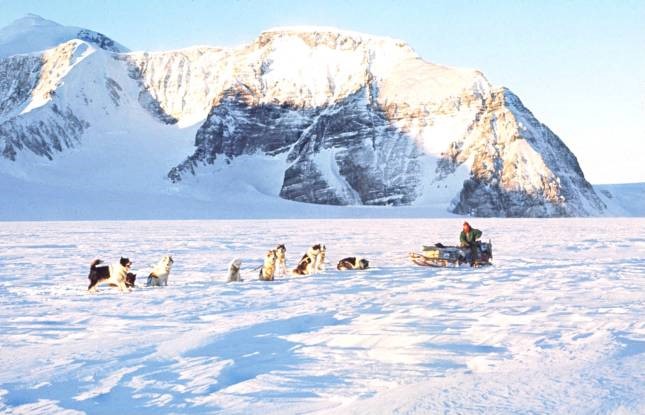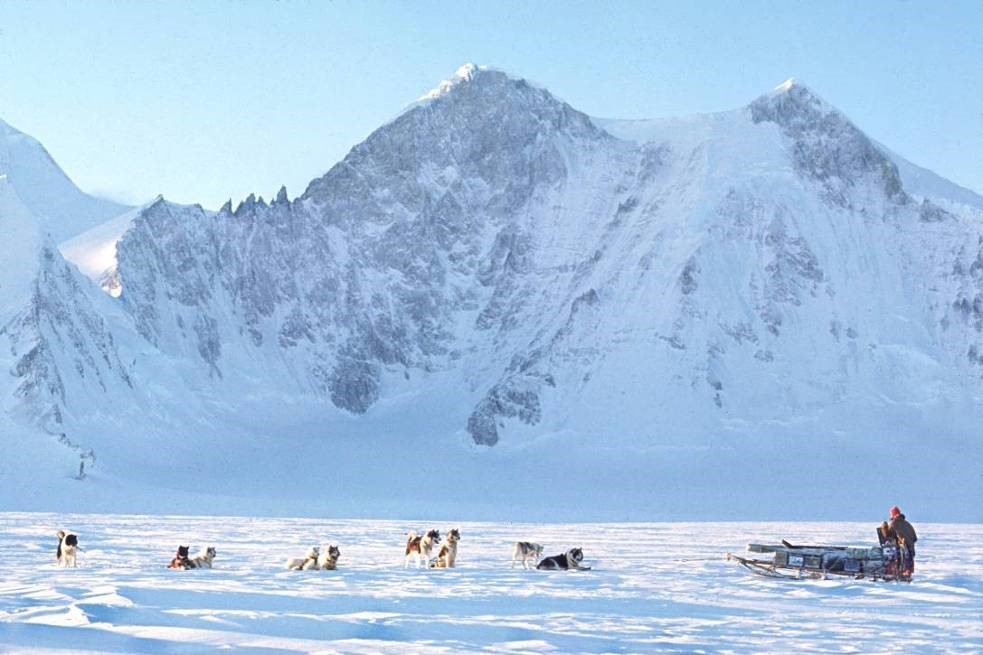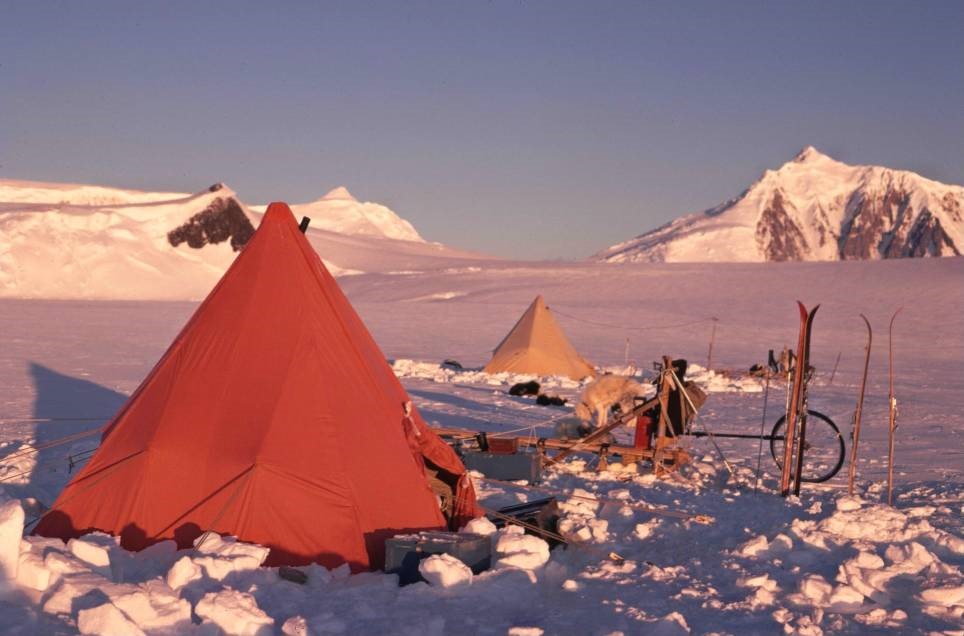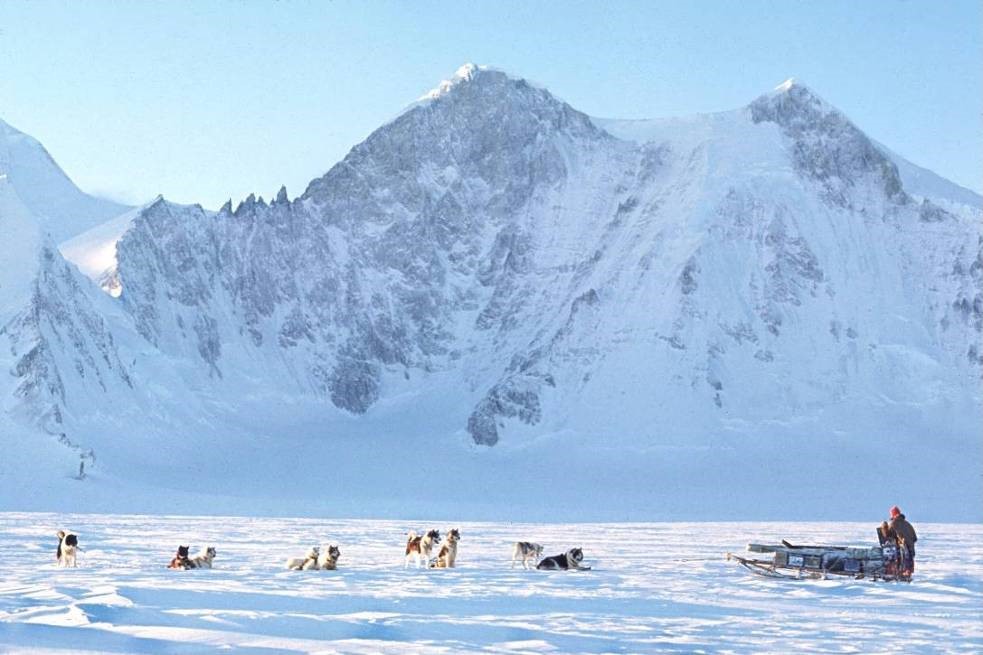Henry then threw his gear together to replace Steve. We were finally away for 1245, by which time the wind had dropped to nothing.”
Count was by far the most experienced leader, so the Huns broke trail. Count was determined to test me and tended to wander about (over the first couple of miles, but then settled down. All the other dogs hauled their hearts out, enabling us to make about 8 miles and camp opposite Trig 6 at around 1550. Cirrus cloud that had been hovering on the western horizon, now began to invade the sky, heralding a northerly blow. Our suspicions were confirmed as Henry and I returned to the Huns tent after spending an evening with Rod and Bob.
No sooner had we turned into our bags than the wind got up and it did not drop until around 1430 the following afternoon, but this was too late for us to consider a move. A littler later, as we wandered around outside to stretch our legs and feed the dogs, it was completely calm, with the cloud sitting on the mountains at around 5500 feet.
We spent the evening in Rod’s tent for the second time, but in spite of Bob’s radio expertise, we had problems with the aerial and failed to make contact with base. For the second night in a row, a breeze was rising as we went to bed, forcing yet another lie-up the next day, when, like the day before, the wind grew less in the early afternoon.
By evening, however, the wind was both falling off and becoming more sporadic, promising us better luck for the morrow. Meanwhile, the afternoon “entertainment” (provided by the Picts to keep us Huns on our toes) was when I heard the crunching of snow under doggy feet outside the tent. I poked my head through the tunnel to see what was going on, and immediately underwent a severe face-licking from Yuri, who had chewed himself off the trace and was now on the prowl for an extra feed.
The next day was near a perfect travelling day as we could hope for this late in the year. As Outside Man, I was out by 0845 to begin the big dig-out that is usually the consequence of a prolonged lie-up. The Picts were ready to move ahead of Henry and me, but we were moving north by 1115, on a surface that was soft on top but firm below.
My Journal notes that:

“… About -15C today. Dogs generally worked well, although once again Count began the day by wandering around. Low drift was whipped up by katabatic winds funnelling down the Sloman Glacier. Kelly (he was a Stonington dog and establishing his place in the team hierarchy) started two fights. Tuva took advantage of the distraction and had a bite at Count’s foreleg. He may have been making a point because earlier I had split him away from Ziggy, his usual partner. But both dogs pulled much better with their new trace pairings, Rita and Otter respectively.”

We only stopped twice; once for lunch; and once to get pictures opposite Pinnacle depot and Mount Liotard. By late afternoon we had covered over 16 miles and camped just above the Lincoln wind-scoop.
The next morning began a day of frustrations. I was Inside Man and prepared breakfast for 0730. On peeping out of the tunnel, I could see a clear cold morning with enough breeze to set up a low drift. The master plan was that Rod and I would run the Huns into the depot site, while Henry and Bob began packing the gear, but Rod over-slept and this delay meant that the wind and drift were kicking up by the time we got going. With Rod sitting on the depot supplies and me riding the foot-plate, we reached the depot in conditions that were already uncomfortable to work in, but soon reached the conclusion that the proposed re-siting was not the best option, therefore the stores were best left where they were. By the time we got back to the tents, it was too blowy to move, but in the hope of an improvement, we sat around in Rod’s tent, leaving the Huns in harness and gear partly packed, ready to go at short notice. But the improvement failed to materialise, forcing us to unpack, re-established camp in the usual manner, and put all the dogs on their proper spans for another night in the same camp.

The wind that kept us from moving was a cold southerly. Given that it was about -20C, the wind chill had to be taken seriously. But the bigger issue was the drift was made up of very tiny ice spicules that found their way into every nook and cranny – a problem compounded by the Huns tent having a rip in the fabric of our inner tent. This had to be repaired in the field, and we eventually got this done during the evening, only to find we had another problem on our hands. The Tilley was not burning properly; it was giving off fumes and providing poor light. Resorting to candlelight and torches, this was resolved by fitting a new mantle, after which we settled down to a comfortable evening, while outside the tent, the wind had picked up yet again.
By next morning (17th) the conditions were marginally better than the previous day. It was still about -20C, but the sky was clear and the drifting snow not quite so bad. We decided to go for it and packed to be away before midday. At first the going was soft, but as we began to descend from the plateau between Lincoln and Depot 5, the surface improved and our speed began to pick up. Soon, Henry and I were running to keep up and the dogs seemed to sense that we were potentially on a run for home, where a feed of seal would be the reward for their efforts.

The snow surface got better as we got closer to base and the dogs kept up their great work rate. Just 4.25 hours after setting off from Lincoln, having covered 24 miles and descended over 2000 feet, we swept down the Ramp and brought the teams to a halt in the High Street. A letter records:
“I shall be lucky if I ever get in a better day’s sledging.”
We put the dogs on their base spans and fed them the seal they rightly deserved. Jobs done, we could take stock. Yes we were tired, but we were also very satisfied with how the day had gone. And all this had been achieved without any dog fights!
I wrote the official Journey Report for this trip. It concludes:
“Lincoln Depot cannot be improved upon without making an approach to a rock site very difficult. The dogs worked steadily, and the last day’s journey is a suitable testimony to the way in which they are improving by constant use.

